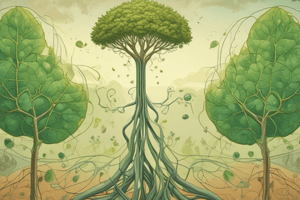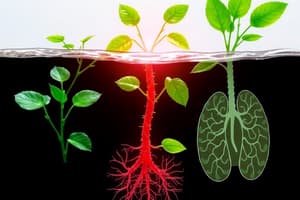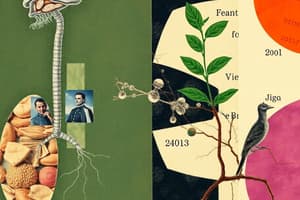Podcast
Questions and Answers
What is the primary product of cellular respiration in mitochondria?
What is the primary product of cellular respiration in mitochondria?
- Oxygen
- Carbon dioxide
- Glucose
- ATP (correct)
Which stage of respiration involves the breakdown of glucose into pyruvate?
Which stage of respiration involves the breakdown of glucose into pyruvate?
- Fermentation
- Citric acid cycle
- Glycolysis (correct)
- Oxidative phosphorylation
What is released during the citric acid cycle?
What is released during the citric acid cycle?
- ATP
- Glucose
- Carbon dioxide (correct)
- NADH
Which of the following statements is true about aerobic respiration?
Which of the following statements is true about aerobic respiration?
What process allows Elysia chlorotica to photosynthesize?
What process allows Elysia chlorotica to photosynthesize?
How much ATP is produced during oxidative phosphorylation per glucose molecule?
How much ATP is produced during oxidative phosphorylation per glucose molecule?
Which type of autotroph uses light energy for growth?
Which type of autotroph uses light energy for growth?
What is the primary energy source that autotrophs use to convert CO2 into organic carbon?
What is the primary energy source that autotrophs use to convert CO2 into organic carbon?
Which of the following groups includes organisms that are both autotrophs and heterotrophs?
Which of the following groups includes organisms that are both autotrophs and heterotrophs?
Which of the following structures is NOT a component of a chloroplast?
Which of the following structures is NOT a component of a chloroplast?
What do heterotrophs depend on for their energy and carbon supply?
What do heterotrophs depend on for their energy and carbon supply?
What was the outcome of Van Helmont's experiment regarding plant biomass?
What was the outcome of Van Helmont's experiment regarding plant biomass?
How many chloroplasts can be found in a single mesophyll cell?
How many chloroplasts can be found in a single mesophyll cell?
What is the role of autotrophs in the ecosystem?
What is the role of autotrophs in the ecosystem?
Which of the following best describes the function of respiration in both autotrophs and heterotrophs?
Which of the following best describes the function of respiration in both autotrophs and heterotrophs?
What does kleptoplasty entail?
What does kleptoplasty entail?
What is the function of chlorophyll located on thylakoid membranes?
What is the function of chlorophyll located on thylakoid membranes?
What term is used for organisms that produce their own food using photosynthesis?
What term is used for organisms that produce their own food using photosynthesis?
Which of the following accurately represents the relationship between autotrophs and the ecosystem?
Which of the following accurately represents the relationship between autotrophs and the ecosystem?
Which of the following correctly describes a feature of chloroplasts?
Which of the following correctly describes a feature of chloroplasts?
Which process is fundamentally impacted by autotrophs transforming inorganic carbon into organic carbon?
Which process is fundamentally impacted by autotrophs transforming inorganic carbon into organic carbon?
What is the primary role of the H+ gradient in ATP synthesis?
What is the primary role of the H+ gradient in ATP synthesis?
Which of the following correctly lists the products of non-cyclic electron flow?
Which of the following correctly lists the products of non-cyclic electron flow?
What is the first phase of the Calvin cycle primarily focused on?
What is the first phase of the Calvin cycle primarily focused on?
Which molecule is combined to regenerate ribulose bisphosphate in the Calvin cycle?
Which molecule is combined to regenerate ribulose bisphosphate in the Calvin cycle?
What process drives photo-phosphorylation during the light reactions?
What process drives photo-phosphorylation during the light reactions?
During the Calvin cycle, which molecules provide the energy necessary for sugar production?
During the Calvin cycle, which molecules provide the energy necessary for sugar production?
What is produced during the phosphorylation and reduction phase of the Calvin cycle?
What is produced during the phosphorylation and reduction phase of the Calvin cycle?
Why is the Calvin cycle considered an important process for living organisms?
Why is the Calvin cycle considered an important process for living organisms?
What is the primary purpose of the C4 cycle in C4 plants?
What is the primary purpose of the C4 cycle in C4 plants?
What adaptation do C4 plants employ to maintain CO2 concentrations?
What adaptation do C4 plants employ to maintain CO2 concentrations?
Which enzyme is responsible for binding CO2 to phosphoenolpyruvate in C4 metabolism?
Which enzyme is responsible for binding CO2 to phosphoenolpyruvate in C4 metabolism?
What is a disadvantage of C4 metabolism compared to C3 metabolism?
What is a disadvantage of C4 metabolism compared to C3 metabolism?
In which conditions are most C4 plants typically found?
In which conditions are most C4 plants typically found?
What is the primary role of chlorophyll in the process of photosynthesis?
What is the primary role of chlorophyll in the process of photosynthesis?
Which of the following best describes the two-step process of photosynthesis?
Which of the following best describes the two-step process of photosynthesis?
What does the redox process in light reactions involve?
What does the redox process in light reactions involve?
What are the products of the light reactions in photosynthesis?
What are the products of the light reactions in photosynthesis?
Why is the temperature of crops an important factor in understanding photosynthesis efficiency?
Why is the temperature of crops an important factor in understanding photosynthesis efficiency?
What is the function of Photosystem II and Photosystem I in photosynthesis?
What is the function of Photosystem II and Photosystem I in photosynthesis?
Which molecule is primarily produced as a reducing energy source during non-cyclic electron flow?
Which molecule is primarily produced as a reducing energy source during non-cyclic electron flow?
What kind of light energy interaction occurs when chlorophyll returns to its ground state?
What kind of light energy interaction occurs when chlorophyll returns to its ground state?
What is the significance of the Calvin cycle in photosynthesis?
What is the significance of the Calvin cycle in photosynthesis?
Who is known as the 'father of the soft-drink' due to his invention related to gases in liquids?
Who is known as the 'father of the soft-drink' due to his invention related to gases in liquids?
Flashcards
Autotrophs
Autotrophs
Organisms that manufacture their own food from inorganic sources, like carbon dioxide, using external energy. They are the primary producers in ecosystems.
Heterotrophs
Heterotrophs
Organisms that obtain their food by consuming other organisms, from plants to animals, to extract organic carbon and energy.
Photosynthesis
Photosynthesis
The process by which plants and certain other organisms convert light energy into chemical energy, producing sugars from carbon dioxide and water.
Carbon cycle
Carbon cycle
Signup and view all the flashcards
Decomposers
Decomposers
Signup and view all the flashcards
Parasitic plant
Parasitic plant
Signup and view all the flashcards
Respiration
Respiration
Signup and view all the flashcards
Cellular respiration
Cellular respiration
Signup and view all the flashcards
Kleptoplasty
Kleptoplasty
Signup and view all the flashcards
Partial endosymbiosis
Partial endosymbiosis
Signup and view all the flashcards
Photo-autotrophs
Photo-autotrophs
Signup and view all the flashcards
Chemo-autotrophs
Chemo-autotrophs
Signup and view all the flashcards
Mesophyll (parenchyma)
Mesophyll (parenchyma)
Signup and view all the flashcards
Chloroplast
Chloroplast
Signup and view all the flashcards
Endosymbiosis & origin of the chloroplast
Endosymbiosis & origin of the chloroplast
Signup and view all the flashcards
Photosynthesis reaction stages
Photosynthesis reaction stages
Signup and view all the flashcards
Light reactions
Light reactions
Signup and view all the flashcards
Dark reactions (Calvin cycle)
Dark reactions (Calvin cycle)
Signup and view all the flashcards
Redox process
Redox process
Signup and view all the flashcards
Photosystems in photosynthesis
Photosystems in photosynthesis
Signup and view all the flashcards
Photosystem
Photosystem
Signup and view all the flashcards
Non-cyclic electron flow
Non-cyclic electron flow
Signup and view all the flashcards
NADPH
NADPH
Signup and view all the flashcards
ATP
ATP
Signup and view all the flashcards
Water splitting
Water splitting
Signup and view all the flashcards
Acidification of the lumen
Acidification of the lumen
Signup and view all the flashcards
ATP synthesis
ATP synthesis
Signup and view all the flashcards
Chemiosmosis in photosynthesis
Chemiosmosis in photosynthesis
Signup and view all the flashcards
Products of non-cyclic electron flow
Products of non-cyclic electron flow
Signup and view all the flashcards
Calvin cycle dependence on light reactions
Calvin cycle dependence on light reactions
Signup and view all the flashcards
Carbon fixation in Calvin cycle
Carbon fixation in Calvin cycle
Signup and view all the flashcards
Photosynthesis and Respiration: Opposite Processes
Photosynthesis and Respiration: Opposite Processes
Signup and view all the flashcards
C4 Plants and Low CO2
C4 Plants and Low CO2
Signup and view all the flashcards
C4 Plants: Heat/Drought Adaptability
C4 Plants: Heat/Drought Adaptability
Signup and view all the flashcards
Cellular Respiration: The Energy Source
Cellular Respiration: The Energy Source
Signup and view all the flashcards
Mitochondrial Respiration: Oxygen-powered Energy Production
Mitochondrial Respiration: Oxygen-powered Energy Production
Signup and view all the flashcards
What is C4 photosynthesis?
What is C4 photosynthesis?
Signup and view all the flashcards
What are bundle sheath cells?
What are bundle sheath cells?
Signup and view all the flashcards
What role does phosphoenolpyruvate carboxylase (PEPC) play in C4 photosynthesis?
What role does phosphoenolpyruvate carboxylase (PEPC) play in C4 photosynthesis?
Signup and view all the flashcards
How is C4 leaf anatomy related to its function?
How is C4 leaf anatomy related to its function?
Signup and view all the flashcards
What is the trade-off of C4 photosynthesis?
What is the trade-off of C4 photosynthesis?
Signup and view all the flashcards
Study Notes
Photosynthesis Overview
- Photosynthesis is a process that affects the entire planet.
- It involves the conversion of light energy into chemical energy (sugars).
- The process uses carbon dioxide and water, and produces oxygen and carbohydrates.
Photosynthesis Details (Campbell and Reece)
- Edition 7, 8, and 9 of Campbell and Reece's work contains information on photosynthesis, within Chapter 10.
- Chapter 10 includes an overview, and details on specific concepts (10.1, 10.2, 10.3, 10.4) excluding specific sections on 'cyclic electron flow', and 'photorespiration'.
- Chapter 9 also contains an overview, concentrating on the stages of cellular respiration within concept 9.1.
Photosynthesis and the Biosphere
- Photosynthesis significantly affects the biosphere, atmosphere, hydrosphere and lithosphere.
The Pyramid of Life
- The pyramid of life illustrates the flow of energy from the base (photosynthesizing organisms) to the top (carnivores).
- Photosynthesizing organisms capture energy from photons of sunlight, and energy flows up through herbivores, and carnivores.
Autotrophs and Heterotrophs
- Autotrophs: Utilize inorganic carbon (e.g., CO2), and require an outside energy source to produce organic compounds (e.g., sugars).
- Plants, algae, and prokaryotes are autotrophs.
- Heterotrophs: Need an organic supply of carbon (e.g., sugars), and depend on dead or living biological material to obtain energy.
- Consumers such as herbivores, carnivores, and decomposers are heterotrophs. Plants can sometimes be heterotrophs (for e.g. broomrape).
- Autotrophs and heterotrophs both oxidise organic carbon to produce CO2 via respiration.
The Carbon Cycle
- The carbon cycle demonstrates the movement of carbon throughout the environment (atmosphere, land plants, soil, ocean)
- Relevant factors include combustion, destruction of vegetation, photosynthesis, respiration, and decay of organic matter.
- Relevant quantities of carbon are in billion tonnes.
Leaf Structure
- Leaves have multiple parts, including the upper and lower epidermis, cuticle, palisade parenchyma, spongy parenchyma, guard cells, xylem, phloem, and stoma.
- Chlorophyll located in mesophyll (parenchyma) cells.
- Mesophyll cells contain up to 40 chloroplasts in each cell.
- Chlorophyll contributes to the leaves' green colour.
Chloroplast Structure
- Chloroplasts possess an outer membrane, inner membrane, stroma, and thylakoids that are stacked in structures called grana.
Endosymbiosis Theory
- The endosymbiosis theory explains how chloroplasts evolved from photosynthetic prokaryotes.
- Unicellular photosynthetic algal cells were absorbed by a heterotrophic host cell, and became incorporated into the host cell's digestive system.
Chloroplast Components
- Chloroplasts possess a double membrane, chloroplast DNA (ctDNA), thylakoid membranes.
- Thylakoids are stacked in grana; stroma, and chlorophyll is located on thylakoid membranes.
- Internal lumen is a compartment inside thylakoid membranes.
Historical Discoveries
- Jan Baptista van Helmont (early 1600s): investigated the source of plant biomass, questioning whether soil was a primary source.
- Joseph Priestley (1733-1804): studied air, bad air, and dephlogisticated air (oxygen).
Chlorophyll and Light
- Chlorophyll absorbs light energy; absorbing a photon.
- Excited electrons subsequently fall back to ground state, releasing energy as heat or fluorescence.
- Photons excite chlorophyll and trigger various reactions.
Photosynthesis: A Two-Step Process
- Light reactions: Convert light energy into chemical energy (ATP and NADPH).
- Dark reactions (Calvin cycle): Incorporate CO2 into sugars using energy from light reactions.
Light Reactions (Detail)
- Light reactions are a redox process, involving the transfer of electrons from a donor (water) to an acceptor molecule with a lower redox potential, driven by energy absorbed from light photons.
- The process involves two photosystems (PSII and PSI) operating sequentially (in order).
Light Reactions (Product 1)
- NADPH: a form of reducing energy (energy plus electrons)
- NADPH is essential for later steps.
Light Reactions (Product 2)
- ATP: a form of chemical energy for cellular processes.
- ATP is essential for later steps in the Calvin Cycle.
Water Splitting
- Water splitting is integral to light reactions.
- 2 H₂O is converted into 4 H⁺ + O₂ + 4 e⁻
Acidification of the Lumen
- H+ ions accumulate within the thylakoid space, creating a gradient used to produce ATP.
- This process is driven by the generation of a H+ ion gradient between the thylakoid space and the stroma.
ATP Synthesis
- Energy stored in the H⁺ gradient is used by ATP synthase to generate ATP, through a process known as chemiosmosis.
- Chemiosmosis involves protons moving through a selectively permeable membrane, from high to low concentration.
- Such movement creates energy used in phosphorylation.
End-products of Non-cyclic Electron Flow
- NADPH: a reducing agent for dark reactions
- ATP: energy in a usable form for dark reactions
Calvin Cycle Phase 1 (Carbon Fixation)
- CO2 is linked to Ribulose Bisphosphate (RuBP).
- The enzyme RuBP carboxylase (Rubisco) plays a key role in this step, combining the two, while forming an unstable 6-carbon molecule, which immediately splits into two molecules of 3-Phosphoglycerate.
Calvin Cycle Phase 2 (Reduction/Phosphorylation)
- 3-Phosphoglycerate is phosphorylated using ATP.
- Then, 3-Phosphoglycerate is reduced using NADPH to produce Glyceraldhyde 3-phosphate.
Calvin Cycle Phase 3 (Regeneration)
- 5 out of 6 molecules of glyceraldehyde 3-phosphate are used to regenerate ribulose bisphosphate (RuBP), the carbon acceptor.
- The regeneration process converts 5 molecules of Glyceraldehyde 3-phosphate into 3 molecules of Ribulose bisphosphate (RuBP).
- This allows the cycle to continue, incorporating more CO2.
C4 Metabolism
- Adaptations that increase leaf CO2 concentrations without increasing transpiration.
- Gather all available CO2 into a small group of cells, a Calvin cycle prefaced with C4-cycle.
- CO2 is initially fixed to phosphoenolpyruvate (PEP), which is converted to a four carbon compound.
C4 Mechanism
- The 4-carbon compound is transported to bundle sheath cells.
- There, it releases CO₂ to be incorporated into the Calvin cycle.
- C3 compounds return to the mesophyll cells to start the cycle again.
C4 Function Linked to Structure
- In C4 plants, bundle sheath cells are responsible for fixing carbon dioxide via the Calvin Cycle.
- The rest of the mesophyll cells collect CO₂, and carry it over as a 4-carbon compound to bundle sheath cells.
C4 Operation
- Some key enzymatic steps that enable C4 metabolism include the binding of CO2 to phosphoenolpyruvate (PEP) by phosphoenolpyruvate carboxylase (PEPC), formation of a four-carbon compound (C4), transportation of that compound to bundle sheath cells, CO2 release in bundle sheath cells, and returning C3 molecules back to mesophyll cells to start the Calvin Cycle.
C4 Advantages
- They operate at very low CO2 levels (high affinity for CO2).
- They have a large catchment area for CO2.
- Thus, they work as a concentrating mechanism.
C4 Plants and Climate Issues
- C4 plants are well-adapted to hot and dry environments, and may play an important role in adapting plants under climate change.
Mitochondrial Respiration
- The process of aerobic respiration converts chemical energy in complex molecules (such as sugars, for example) into ATP.
Differences from Photosynthesis
Mitochondrial respiration is distinct from photosynthesis. Respiration involves obtaining chemical energy from complex molecules like sugars to create ATP, and is a shared process between animals and plants.
Three Stages of Respiration
- Glycolysis: Breakdown of glucose into pyruvate.
- Citric Acid Cycle (Krebs Cycle): Breakdown of pyruvate to CO2.
- Oxidative Phosphorylation: Use of electron transport chain to oxidize NADH and FADH2 via electron transport, generating a high concentration gradient and ultimately ATP production.
Other Points
- Fermentation is a type of anaerobic respiration, distinct from the aerobic version in that occurs outside mitochondria and is less efficient in producing ATP.
Studying That Suits You
Use AI to generate personalized quizzes and flashcards to suit your learning preferences.




